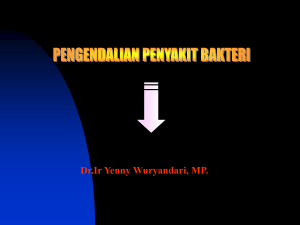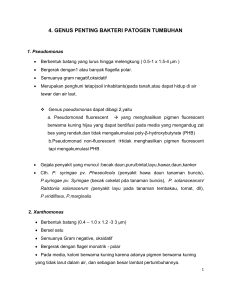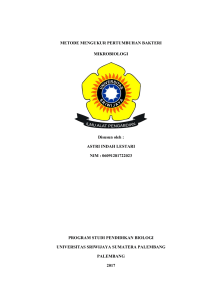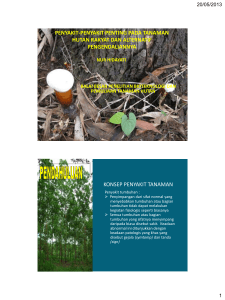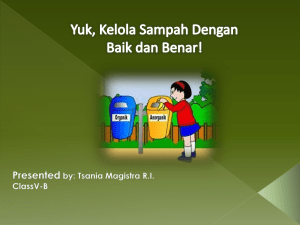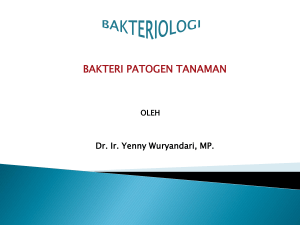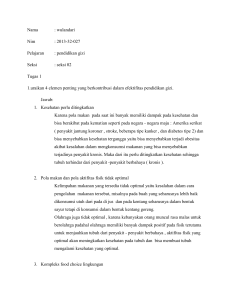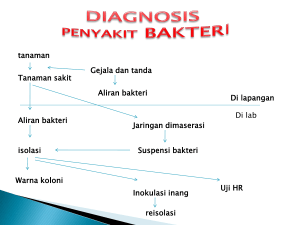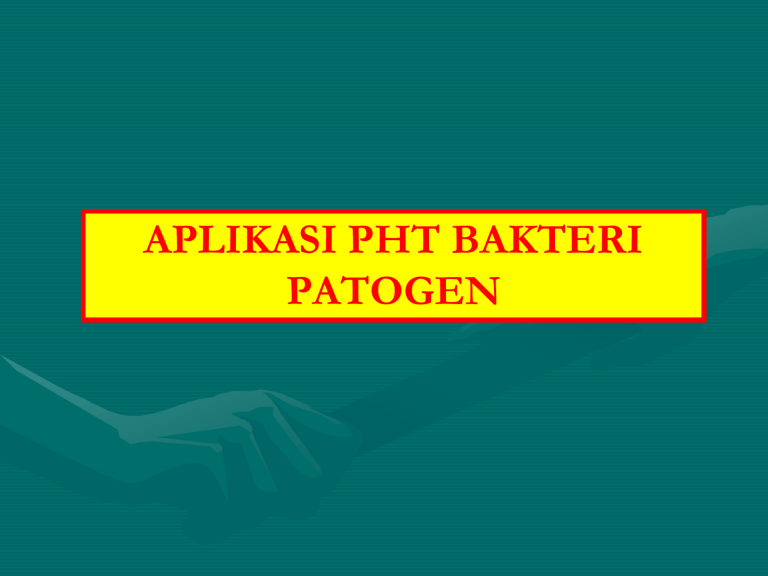
APLIKASI PHT BAKTERI PATOGEN EKOLOGI DAN PENYEBARAN BAKTERI PATOGEN Bakteri patogen hidup sbg parasit, saprofit dan epifit. BIOFILMS SOIL INHABITANTS: agrobacterium tumefaciens, Ralstonia solanacearum, Streptomyces scabies SOIL INVADERS: Erwinia amylovora, Xanthomonas campestris Aerobic, anaerobic, dan facultative anarobic Autotrophs dan heterotrophs Bertahan di dalam tanah dalam jaringan tanaman, beberapa hidup bebas secara saprofit, dlm benih, bag tumbuhan lain, serangga, scr epifit, pd tunas, luka dan eksudatnya, ada yang bertahan dengan membentuk bacterial ooze. Penyebaran bakteri: air, serangga, hewan, dan manusia (Pasif); flagela (Aktif). Massa bakteri Bakteri patogen tdk terlepas lingkungan yg mempengaruhi: dari faktor 1. Suhu udara Scr langsung mempengaruhi multiplikasi bakteri patogen dan insidensi perkemb. Penyakit Mempengaruhi kerentanan tan inang Suhu pertumbuhan optimum, maks, dan min berbeda tgt pada spesies atau strain bakteri. Tabel. Suhu pertumbuhan bakteri Min (o C) Opt (o C) Maks (o C) 0,5-3 28-30 > 37 E. carotovora subsp. atroseptica 3 27 32-35 E. carotovora subsp. carotovora 6 27 35-37 E. chrysanthemi pv. zeae 6 37 40-41 1,5 22-30 37-38 P. avenae 0 30-35 40 P. caryophylli 5 30-33 46 P. cepacia 6-9 30 42 R. solanacearum 10 35-37 41 P. syringae pv. glycinea 2 24-26 35 P. syringae pv. lachrymans 1 25-27 35 P. syringae pv. maculicola 0 24-25 29 2,5 20-23 33 7 27-28 37,5 Bakteri Erwinia amylovora Pseudomonas andropogonis P. syringae pv. phaseolicola P. syringae pv. pisi Tabel. Suhu pertumbuhan bakteri Min (o C) Opt (o C) Maks (o C) Xanthomonas campestris pv. begoniae 1-3 27 37 X. campestris pv. campestris 7-10 28-30 36 10 28-30 38 X. campestris pv. malvacearum 7-10 25-30 36-38 X. oryzae pv. oryzae 5-10 26-30 40 X. campestris pv. pruni 7-10 24-29 37 0 25-30 37 Bakteri X. campestris pv. citri Agrobacterium tumefaciens - Kel Pseudomonas mengeluarkan enzim tertentu (protease dan phosphatase) secara maksimal pd suhu 15-20 o C. - Suhu rendah berperanan dalam biosintesis dan sekresi faktor virulensi, serta bertanggung jawab terhadap prevalensi penyakit. Mis: P. syringae pv. phaseolicola menghasilkan phaseolotoksin pada suhu 15-20 o C dan bakteri tsb terlindung dari racunnya oleh phaseolotoxin-tolerant ornithine carbamoyl-transferase yg dihasilkan pd suhu rendah 2. Suhu tanah R. solanacearum (ras 1) tdk menyebabkan gejala layu jika suhu tanah di bawah 21 oC R. solanacearum (ras 3) menyebabkan gejala layu pada suhu tanah 21 oC 3.Kelembapan udara Lingk dg kelembapan tinggi sangat menguntungkan interaksi Kelembapan relatif (RH) scr langsung/tdk langsung mempengaruhi air bebas pd permukaan tanaman. Kelembapan relatif (RH) mempengaruhi eksudat bakteri, pop bakteri epifit, dan interaksi patogen dan m.o. Saprofit pd permukaan daun. Mis: - Angular leaf spot pd cucumber oleh Pseudomonas syringae pv. lachrymans memerluksn kelembapan tinggi unt perkemb penyakit. - Xanthomonas oryzae pv. oryzicola (bacterial leaf streak pd padi), E. amylovora (fire blight pd apel), jumlah ooze meningkat pd RH tinggi dan cepat turun pd RH rendah. 4. 1. 2. Kelembapan tanah penyebaran Daya tahan bakteri dlm tanah Proses infeksi akar Ketahanan tan inang Insidensi & severitas bakteri patogen Mis: E. carotovora subsp. Carotovora tdk menyebabkan soft rot pd jar parenkim Chinese cabbage jika di lingk dh RH 30% selama 2 jam. Kelembapan tanah adalah faktor kritis dlm perkemb penyakit yg disebabkan oleh bakteri (Mis: penyakit scab). 5. Angin p Angin menyebabkan daun, batang, dan akar rusak/luka shg dpt mjd pintu masuk bakteri. 6. Sinar matahari • Berpengaruh thd fungsi fisiologi tan (fotosintesis dan respirasi) • Meningkatkan/mengurangi kerentanan thd bakteri patogen Mis: X. campestris pv. carotae lebih berat serangannya pd intensitas cahaya tinggi (30.140 lux) drpd intensitas cahaya rendah (21.520 lux) 6. Sinar matahari • Mempengaruhi perkembangan gejala Mis: Halo blight pd daun Rye, gejala tdk tampak pd intensitas cahaya penuh (1425 µW/cm2) • Intensitas cahaya tdk mempengaruhi laju multiplikasi bakteri patogen dlm jaringan. 7. Nutrisi o o Nutrisi mempengaruhi perkembangan penyakit tanaman yg disebabkan oleh bakteri Tan menunjukkan pertumb maks dan ketahanan penyakit meningkat pd waktu pemupukan (nitrogen, potasium, magnesium, fosfat, dan calsium). MACAM PENYAKIT TANAMAN YANG DISEBABKAN OLEH BAKTERI Tipe-tipe Utama Penyakit krn Bakteri 1. Blight dan Kanker ☺ Dimulai dg daerah lokal kematian sel (nekrosis) pd daun, polong, bercak buah, kematian bunga (blight) atau bercak batang (kanker). ☺ Mjd sistemik dan menyebar melalui tanaman ☺ Patogennya disebut necrogen 2. Layu Pembuluh ☺ Istilah ini digunakan, jika xylem vessel diserang oleh patogen necrogen dan menyebabkan kelayuan. ☺ EPS mempunyai peranan penting dlm perkemb penyakit ☺ Enzimnya berperanan dalam mendegradasi ddg sel dan menghambat pengatur pertumbuhan tan. 3. Soft Rots ♠ Penyakit tjd, jika sel inang terpisah shg menyebabkan jar runtuh, mati, busuk, dan menjadi lembap. ♠ Patogennya disebut acergen/ macerators/ soft rotters 4. Galls ۩ Bentuk ini sbg hasil perkembangan sel yang menyebabkan pertumbuhan jar/akar, batang, dan daun seperti kanker. ۩ Patogennya disebut oncogen Tipe penyakit Jar yg diserang Jenis gejala Jenis patogen Bercak daun Menyerang ruang antar sel dan nekrotisasi jar parenkim Bercak kebasahan, eksudat bakteri, halo blight, hawar daun, bercak buah Pseudomonas Xanthomonas Kanker Menyerang jar kulit dan berkayu mll luka, kelopak daun, daun muda dan bunga Nekrosis kulit, gumosis, hawar pucuk, daun berlubang, busuk tunas P. syringae pv. syringae Kanker, oose bakteri, hawar bunga dan ranting, nekrosis kulit Layu pembuluh Menyerang jar pembuluh Layu, kerdil, jar pembuluh mjd coklat, busuk melingkar pd kentang, bercak mata burung pd buah tomat E. amylovora Coryneform, R. solanacearum, bbrp Xanthomonas, Erwinia, Mikoplasma, Phytoplasma, Spiroplasma, Xyllela Tipe penyakit Jar yg diserang Jenis gejala Jenis patogen Busuk lunak Maserasi pd lamela tengah dan dinding sel primer Busuk lunak pd umbi kentang, bawang, busuk kaki hitam Erwinia dan bbrp Pseudomonas Proliferasi dan tumor Merangsang pertumbuhan sel dan jar tanaman mjd abnormal Crown gll, gall pd ranting, akar rambut, fasiasi Agrobacterium, P. s. Pv. savastoni Tabel . Keragaman gejala penyakit nekrotik yang disebabkan oleh bakteri Gejala Patogen Bercak daun Pseudomonas syringae pv. phaseolicola P. syringae pv. tabaci Xanthomonas campestris pv. malvacearum X.campestris pv. glycines Hawar halo Buncis wildfire Tembakau Bercak bersudut Kapas Pustul bakteri Kedelai X. oryzae pv. oryzae Hawar daun bakteri Padi Hawar bunga Prunus sp. Rosaceae Hawar daun Hawar bunga P. syringae pv. syringae Kanker dan mati meranting Penyakit P. syringae pv. morsprunorum Kanker P. syringae pv. syringae Erwinia amylovora Kanker Kanker dan fire blight Inang Rosaceae Rosaceae Tabel. Bakteri yang menyebabkan penyakit layu Bakteri Penyakit Inang Clavibacter michiganensis subsp. michiganensis C. michiganensis subsp. insidiosum C. michiganensis subsp. sepedomicum C. xyli subsp. xyli Panthoea sterwatii Erwinia trachephyla Ralstonia solanacearum Xyllella fastidiosa Layu Tomat Layu Alfalfa Layu Umbi kentang Layu Tebu Layu Jagung Layu Ketimun Layu Banyak Penyakit Pierce’s Banyak X. oryzae pv. oryzae Kresek Padi X. campestris pv. campestris Busuk hitam Kubis Pseudomonas schyzigii Penyakit mati bujang (Sumatera disease) Cengkeh Tabel. Bakteri yang menyebabkan busuk lunak Bakteri Xanthomonas campestris pv. Penyakit Inang Faktor Iklim Busuk hitam Kubis-kubisan Dingin, iklim sedang Erwinia carotovora subsp. carotovora Kaki hitam, busuk lunak Kentang, banyak inang Panas, iklim tropis E. carotovora subsp. atroseptica Kaki hitam, busuk lunak Kaki hitam, busuk lunak Dingin, iklim sedang E. chrysanthemi Kaki hitam, busuk lunak Kaki hitam, busuk lunak Iklim subtropis dan rumah kaca Clavibacter michiganensis subsp. sepedonicum Busuk melingkar Kentang, banyak inang Terutama di AS, Rusia, Skandinavia Pseudomonas fluorescens Busuk lunak Sayuran, buahbuahan Bacillus Busuk Tembakau yg disimpan Clostridium Busuk Bibit tomat dan kedelai campestris Tipe-tipe Patogen Bakteri Genus Gram negatif Spesies, Pathovar Penyakit Agrobacterium tumefaciens Crown gall Erwinia amylovora carotovora pv. carotovora carotovora pv. atroseptica chrysanthemi stewartii Fire blight Soft rots Black leg (kentang) Soft rots Layu bakteri (jagung) Pseudomonas marginalis syringae pv. syringae syringae pv. phaseolicola syringae pv. tabaci syringae pv. savastoni Soft rots Macam-macam Halo blight (bean) Wild Fire (tobacco) Olive knot Ralstonia solanacearum Layu bakteri Genus Gram negatif Xanthomonas Spesies, Pathovar campestris pv. campestris campestris pv. phaseoli Malvacearum albilineans Penyakit Black rot (crucifer) Common blight (bean) Black arm (kapas) Leaf scald (tebu) Gram positif Corynebacterium fascians (Rhodobacterium ) pv. michiganense Corynebacterium michiganense pv. incidiosum (Clavibacter) pv. sepedonicum Leafy gall Bacterial cancer (tomat) Bacterial wilt (Lucerne) Ring rot (kentang) Genus Gram positif Corynebacterium flaccumfaciens (Curtobacterium) Spesies, Pathovar pv. flaccumfaciens Penyakit Bacterial wilt (bean) Necrogen : P. syringae; X. campestris; R. solanacearum Macergen : E. carotovora; E. chrysanthemi; P. marginalis Oncogen : A. tumefaciens; C. fascians Citrus canker symptoms on fruit Crown gall, caused by Agrobacterium tumefaciens Apple Tree Fire Blight Initial halo blight symptoms Brown spot lesions on pods PENGELOLAAN PENYAKIT TERPADU 1. Pendahuluan Integrated disease management (IDM) is a disease control approach that uses all available management strategies to maintain disease pressures below an economic injury threshold. In most cases IDM consists of scouting with timely application of a combination of strategies and tactics. Strategi adl rencana keseluruhan untuk mencapai tujuan tertentu. Taktik adl implementasi untuk menerapkan strategi tertentu 2. The Disease-Triangle Concept The Disease Triangle shows the importance of the three factors necessary for disease development. The disease management principles and practices are often centered around the concept of the Disease Triangle so that management tactics often seek to manipulateone or more of the components of the disease triangle. Disease Cycles Independent of host All pathogens go through a cycle with similar events.” Knowing how particular pathogens go through their disease cycle is important in developing management strategies. 3. Pengelolaan Penyakit bdsk Prinsip Epidemiologi Principles of epidemiology indicates that control measures can do this in only two ways. 1. They may reduce (or delay) disease at the beginning of the season (Xo) or 2. They may decrease the rate of disease development (r) during the growing period. Principles of Plant Disease Control 1.Avoidance—prevent disease by selecting a time of the year or a site where there is no inoculum or where the environment is not favorable for infection. 2.Exclusion—prevent the introduction of inoculum. 3.Eradication—eliminate, destroy, or inactivate the inoculum. 4.Protection—prevent infection by means of a toxicant or some other barrier to infection. 5.Resistance—utilize cultivars that are resistant to or tolerant of infection. 6.Therapy—cure plants that are already infected. Tactics for the Reduction of Initial Inoculum •Avoidance—reduce the level of disease by selecting a season or a site where the amount of inoculum is low or where the environment is unfavorable for infection •Exclusion—reduce the amount of initial inoculum introduced from outside sources •Eradication—reduce the production of initial inoculum by destroying or inactivating the sources of initial inoculum (sanitation, removal of reservoirs of inoculum, removal of alternate hosts, etc.) •Protection—reduce the level of initial infection by means of a toxicant or other barrier to infection •Resistance—use cultivars that are resistant to infection, particularly the initial infection •Therapy— use thermotherapy, chemotherapy and/or meristem culture to produce certified seed or vegetative planting stock Tactics for the Reduction of the Infection Rate •Avoidance—reduce the rate of production of inoculum, the rate of infection, or the rate of development of the pathogen by selecting a season or a site where the environment is not favorable •Exclusion—reduce the introduction of inoculum from external sources during the course of the epidemic •Eradication—reduce the rate of inoculum production during the course of the epidemic by destroying or inactivating the sources of inoculum (roguing) •Protection—reduce the rate of infection by means of a toxicant or some other barrier to infection •Resistance—plant cultivars that can reduce the rate of inoculum production, the rate of infection, or the rate of pathogen development •Therapy—cure the plants that are already infected or reduce their production of inoculum Tactics for the Reduction of the Duration of the Epidemic •Avoidance—plant early maturing cultivars or plant at a time that favors rapid maturation of the crop •Exclusion—delay the introduction of inoculum from external sources by means of plant quarantine Macam pengelolaan Berpengaruh pada A. Menghindari patogen 1. Pemilihan daerah geografi Xo r 2. Pemilihan tempat penanaman Xo r 3. Pemilihan tanggal penanaman Xo r 4. Penggunaan tanaman bebas penyakit Xo 5. Modifikasi bercocok tanam r Macam pengelolaan Berpengaruh pada B. Eksklusi patogen 1. Perlakuan biji atau bahan tanaman Xo 2. Inspeksi dan sertifikasi Xo 3. Eksklusi dengan karantina tumbuhan Xo 4. Eliminasi vektor serangga Xo r Macam pengelolaan Berpengaruh pada C. Eradikasi patogen 1. Pengendalian hayati patogen tumbuhan Xo 2. Rotasi tanaman Xo r 3. Pemusnahan tanaman rentan atau bagian tanaman sakit yaitu dengan: a. Roguing Xo b. Eliminasi inang alternate dan inang gulma Xo c. Sanitasi Xo 4. Perlakuan panas dan kimia Xo 5. Perlakuan tanah Xo r Macam pengelolaan D. Proteksi tanaman atau Berpengaruh pada perlindungan 1. Penyemprotan atau penghembusan dan perlakuan propagul tanaman untuk melindungi dari infeksi Xo 2. Pengendalian vektor serangga r 3. Modifikasi lingkungan r 4. Inokulasi dengan virus avirulen untuk melindungi dari virus virulen 5. Modifikasi nutrisi Xo r Macam pengelolaan Berpengaruh pada E. Perkembangan Inang tahan 1. Seleksi dan pemuliaan untuk ketahanan a. Ketahanan vertikal Xo b. Ketahanan horisontal r c. Ketahanan populasi (multilini) r 2. Ketahanan dengan kemoterapi r 3. Ketahanan melalui nutrisi r Macam pengelolaan Berpengaruh pada F. Terapi terhadap tanaman sakit 1. Kemoterapi 2. Perlakuan panas r Xo 4. Achieving Successful Disease Management Successful disease management can be achieved if these measures are followed: Emphasize prevention rather than cure. Monitor crops daily (or at least two times per week) by walking the crop(s) to achieve early detection. The employee responsible for monitoring must work closely with the person responsible for overall crop scheduling and growing. Correct diagnosis is crucial. Because disease pathogens are microscopic, learn to anticipate when possible pathogen infection periods are likely to occur. As a grower/manager, keep detailed records that enable merging of cultural, environmental, and insect and disease data for review when a production problem arises or for doing post season crop summary reviews. Monitor the weather to help anticipate potential disease problems 5. Implementasi Pht Penyakit Tanaman Karena Bakteri Patogen 1. Penyakit Layu Bakteri pd Kentang - Brown rot - Penyakit penting -Kerugian hasil > 75% -Penyebab: Ralstonia solanacearum (R3Bv2) -Gejala: pada daun, batang dan umbi -Ditemukan di Indonesia sejak th 1912 Karakteristik ras R. solanacearum, distribusi, dan biovar Ras Kisaran inang Distribusi Biovar 1 Luas Asia, Australia Amerika 3,4 1 2 Karibia, Brazil, Filipina Dunia Luas 1 4 Pisang & Musa sp. lainnya Kentang, tomat, geranium Jahe Asia 3,4 5 Mulberry Cina 5 3 2 DAUR PENYAKIT LAYU BAKTERI KENTANG Inang &gulma Air irigasi Umbi benih Tanah pada alat, kuku dan sepatu Tanaman inang Sisa panen Tanah Penyakit layu bakteri Kentang Nematoda dalam tanah Umbi dan tanaman kentang Faktor strategi pengelolaan penyakit terpadu layu bakteri kentang ditunjukkan dengan rangking Faktor Strategi Pengelolaan Benih Sehat Kentang tahan atau toleran Tanah bebas R. solanacearum Tanah Supresif Rotasi dengan tanaman bukan inang Pemusnahan tanaman kentang layu Pemusnahan tanaman inang lain Rangking Ras 3 Rangkin g Ras 1 7 4 7 2 5 4 4 7 2 7 2 3 3 2 Faktor strategi pengelolaan penyakit terpadu layu bakteri kentang ditunjukkan dengan rangking Faktor Strategi Pengelolaan Rangking Rangking Ras 1 Ras 3 Pengendalian Gulma 2 2 Menghilangkan sisa panen kentang 3 3 Pengendalian penyebaran air 2 1 Pengendalian minimal setelah perkecambahan Pengendalian nematoda 4 4 3 3 Dekontaminasi alat-alat, kuku & sepatu 2 1 Mengekspos tanah dengan sinar matahari Penggenangan dengan padi sawah 1 3 1 3 2. Penyakit Bacterial leaf blight (Xanthomonas oryzae pv. oryzae ) Pengelolaan Penyakit terpadu: a. Burn the stubbles. Use optimum dose of fertilizers. b. Avoid clipping of tip of seedling at the time of transplanting. c. Avoid flooded conditions. Remove weed hosts. d. Spray Streptomycin sulphate and tetracycline combination 300 g + Copper oxychloride 1.25 g/ha. 3. Penyakit Bacterial leaf streak (Xanthomonas oryzae p.v. oryzicola ) Pengelolaan Penyakit terpadu: a. Burn the stubbles. Use optimum dose of fertilizers. b. Avoid clipping of tip of seedling at the time of transplanting. c. Avoid flooded conditions. Remove weed hosts. d. Spray Streptomycin sulphate and tetracycline combination 300 g + Copper oxychloride 1.25 g/ha. 4. a. b. c. d. e. Penyakit bacterial panicle blight (Burkholderia glumae and B. gladioli ) Pengelolaan Penyakit terpadu: Most commercial varieties are susceptible, but some show significant partial resistance. Plant early to avoid late season hot temperatures. Avoiding excessive nitrogen rates No pesticides are currently recommended to control this disease. Do not plant seed from fields that were seriously affected the previous year. Penyakit Bacterial spot pd tomat (Xanthomonas campestris pv. vesicatoria ) Pengelolaan Penyakit terpadu: a. Cultural practices and preventive sprays of copper help to manage bacterial spot. b. Avoiding sprinkler irrigation and cull piles near greenhouse or field operations, and rotating with a nonhost crop also helps control the disease. 5.
